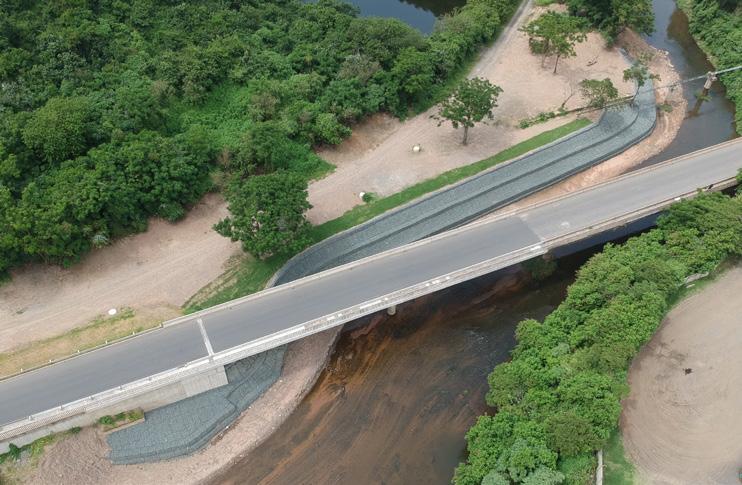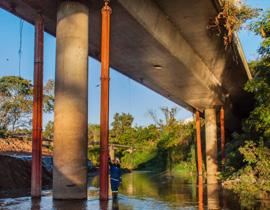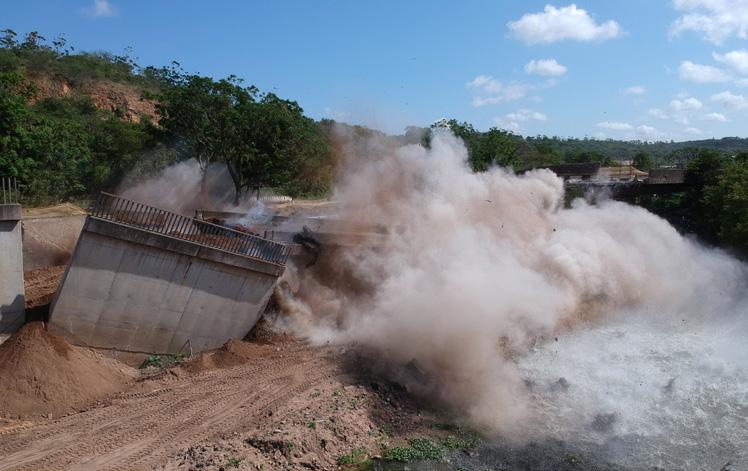
8 minute read
Emergency rehabilitation of the Seaward Road Bridge
from Imiesa February 2022
by 3S Media
Emergency rehabilitation
of the Seaward Road Bridge
Advertisement
The Seaward Road Bridge crossing the Umhlatuzana River in Durban underwent a partial collapse during heavy flooding in April 2019. The common practice worldwide would have been to demolish and rebuild. In this particular case, eThekwini Municipality’s in-house engineering team developed a novel and sustainable alternative, partially reconstructing and lengthening the continuous post-tensioned concrete deck. By Peter Fenton, Jitesh Harripershad & Luke Reid*
Constructed in 1979, the Seaward Road Bridge supports the only direct access between the Umhlatuzana Industrial Park and major road, rail and sea connections in the direction of the Port of Durban.
The 150 m five-span bridge crosses a complex curve in the river, which was originally intended to be canalised. Progressive flooding first eroded the river’s eastern embankment immediately upstream of the bridge, redirecting the flow directly toward the face of the eastern abutment.
The saturated abutment fill pushed the precast piles out of position, then sheared them off. Without the piles, the abutment collapsed, taking a section of the bridge deck with it. The remainder of the deck was not strong enough to perform without the abutment’s support. The deck subsequently twisted over sideways on its bearings and the end span slumped down. Fortunately, no people were harmed in the vicinity during or after the collapse. Access to the industrial park now required an additional 5 km detour over a nearby hill along steep, narrow, winding suburban roads, where trucks had previously been completely forbidden. This was a hazard for both the large trucks carrying shipping containers and heavy machinery, and the local residents, including children walking to school. Congestion from trucks queuing to navigate difficult portions of road could introduce long delays in accessing the industrial park, holding up work and reducing productivity. Pressure to replace the bridge as soon as possible came from both the residential and industrial areas.
Old and new deck sections came together to form the upgraded Seaward Bridge
Analysing the problem
A rudimentary environmental impact assessment for the bridge reconstruction was quickly approved as part of a package of emergency flood repairs on the river. Funding was provided via a Municipal Finance Management Act (No. 56 of 2003) Section 36(1)(a)(i) emergency procurement process with a shortened tender duration. The original as-built drawings were successfully tracked down, and a detailed inspection conducted to map the extent of the strain damage. In terms of the final remediation solution developed, a key advantage was that the prestress cable layout in the bridge deck was extremely simple. All the prestress cables terminate in couplers between the construction stages.
In principle, a replacement deck was only needed in two of the bridge’s original five spans. The original prestress couplers at the construction joint could be used to connect the new deck to the salvaged deck and share its loads. But first the team would need to dismantle a structure that was never meant to be tampered with once completed.
The solution: sewing a prestressed bridge deck back together
The existing deck was completely remodelled and analysed using modern design codes and software. Two key challenges

The collapsed eastern abutment and end span of the Seaward Road bridge over the Umhlatuzana River. Floodwater destabilised the east abutment and sheared it off its piles

The remainder of the existing structure had negligible stability and needed to be carefully propped until construction was complete
immediately presented themselves. First, because the original bridge is 40 years old, its concrete behaves very differently to new concrete when tensioned. Second, the bridge had to be lengthened by 4 m so the piles for the new abutment would not clash with the original driven piles, which remained in the ground. The increased length changed the loading and stiffness of the end span.
The designers needed to be confident that – despite the future variability in prestress losses over time between the old and new sections – the residual force at the prestress coupler would remain balanced and the connection would not be overstressed. The prestress in the new portion of the bridge is thus 64% of ultimate tensile strength, not 70% as per the as-built design.
It was reassuring that when modern NA and NB36 loadings were applied, it was close to a perfect fit – almost on the limit of the confines of a class 2 prestress structure. The lengthening of the bridge resulted in the end span moving from a class 2 prestress condition to a class 3 partially prestressed condition under full traffic loading, and it was designed with this in mind. The end span is thus still very capable of carrying NA and NB loads as per design codes.
Delicate demolition
The collapsed portion of bridge deck needed to be removed without causing the remaining portion to give way. Temporary stability was achieved with the installation of ultra-heavy-duty 1 000 kN props on either side of each pier.
Once a reliable stabilising system was in place, the deck was cut all the way through with a wire saw at a position 2 m away from the 10 critical prestress couplers. The portion to be demolished was stabilised with lightweight, sacrificial falsework props.
Couplers were carefully exposed by hand with sharpened chisels to minimise any microcracking. The existing steel reinforcement was also treated with care so new rebar could be spliced onto it.
When the prestress ducts and cables were examined, none had been
PROJECT TEAM
Client: eThekwini Municipality Design engineers: eThekwini Municipality, Roads Provision Department: Structures Branch Main contractor: Icon Construction Geotechnical contractor: Megapile Post-tensioning: PTS Solutions successfully grouted during the original construction, and the cables could not be treated as homogeneous with the surrounding material. Grout had been introduced into the prestress anchors and couplers but had not travelled into the ducts. Fortunately, there was no indication of corrosion in the unbonded strands, and no violent effects were noted when the cables were cut – presumably due to constrictions and contortions of the ducts during the original collapse, which prevented the prestress energy being released.
Rather than push the damaged deck off its support and demolish it on the ground, it was decided to break it up in situ using chemical explosives, simultaneously with its original supports. This reduced the environmental impact of having a much larger platform in the river alongside the existing footprint, and reduced the time spent breaking up the material for recycling.
Old couplers pose a challenge
A major setback was discovered when the prestress couplers were exposed: the VSL fittings from 1979 are not compatible with the prestress systems available today. Extensive enquiries were made among South African prestress suppliers, but only one of them, OVM, could supply coupling components for 12.9 mm strand. Unfortunately, the swage thickenings supplied by OVM could still not
The new abutment is unusually heavy and sits behind extensive protection works

The deck was sawn 2 m from the existing prestress couplers

fit into the grooves of the old couplers. The only option was to modify the modern swages to fit and test the results in a laboratory empirically.
The first tests aimed to apply 85% of the ultimate load capacity of the strand, for a period of several hours. However, because of difficulties with maintaining the tension in the samples, the samples were then also tested to failure. In all cases, the swages were unaffected, and the strands snapped at a load of around 195 kN. This was about 5% more than their theoretical load capacity of 186 kN. Since the modified swages showed no sign of failure or distress at 195 kN, it was concluded that they could safely carry the tendon design force of 119 kN/strand.
Future-proofing
The irregular bend and susceptibility to flooding of the Umhlatuzana River make it hard to predict its behaviour, and ongoing development upstream will produce stronger flows in the future. The design caters for this. A mass abutment with encapsulated fill material provides the stability to withstand high loads and is protected by very long wingwalls. It sits atop a large, monolithic, three-tier pile cap, which required careful design, detailing and construction monitoring to ensure no thermal or shrinkage cracks occurred in the complex arrangement.
The 39 piles of 500 mm diameter were installed with a specialised ‘overburden drilling eccentric’ method, otherwise known as an Odex or Rota pile. This uses ‘down the hole’ percussion impacting to penetrate boulders and pull down permanent casings. Extensive gabion protection works were added upstream on the eastern bank to prevent a reoccurrence of the flood-related erosion of the riverbank, which had initiated the collapse of the original abutment.
The chosen solution was complex but left the existing footprint of the bridge in the watercourse unchanged, saved 850 m3 of concrete in the existing bridge, and avoided a larger demolition that would have destroyed nearby trees with nesting birds.
All 620 m3 of demolished reinforced concrete was recycled on-site. It was crushed to a maximum particle size of 75 mm and mixed in a 50/50 ratio with excavated material to create G7 material for use in layerworks and abutment fill.
Close coordination
The unusual nature of the project and its many unknowns required extremely close coordination between all construction stakeholders. The design, project management and contract administration were all done by municipality-employed engineers, who could also take major decisions as representatives of the client and engage with risk management in a knowledgeable way with the experienced contractor, Icon Construction.
The entire project, including design, procurement, and construction ran over 18 months, from May 2019 to September 2020, and was within its budget of R36 848 530.
*eThekwini Municipality, Roads Provision Department: Structures Branch
This is an edited version of a paper presented at the IMESA 2021 Virtual Conference. The full version can be downloaded from the IMESA website at www.imesa.org.
The damaged spans were demolished with explosives











